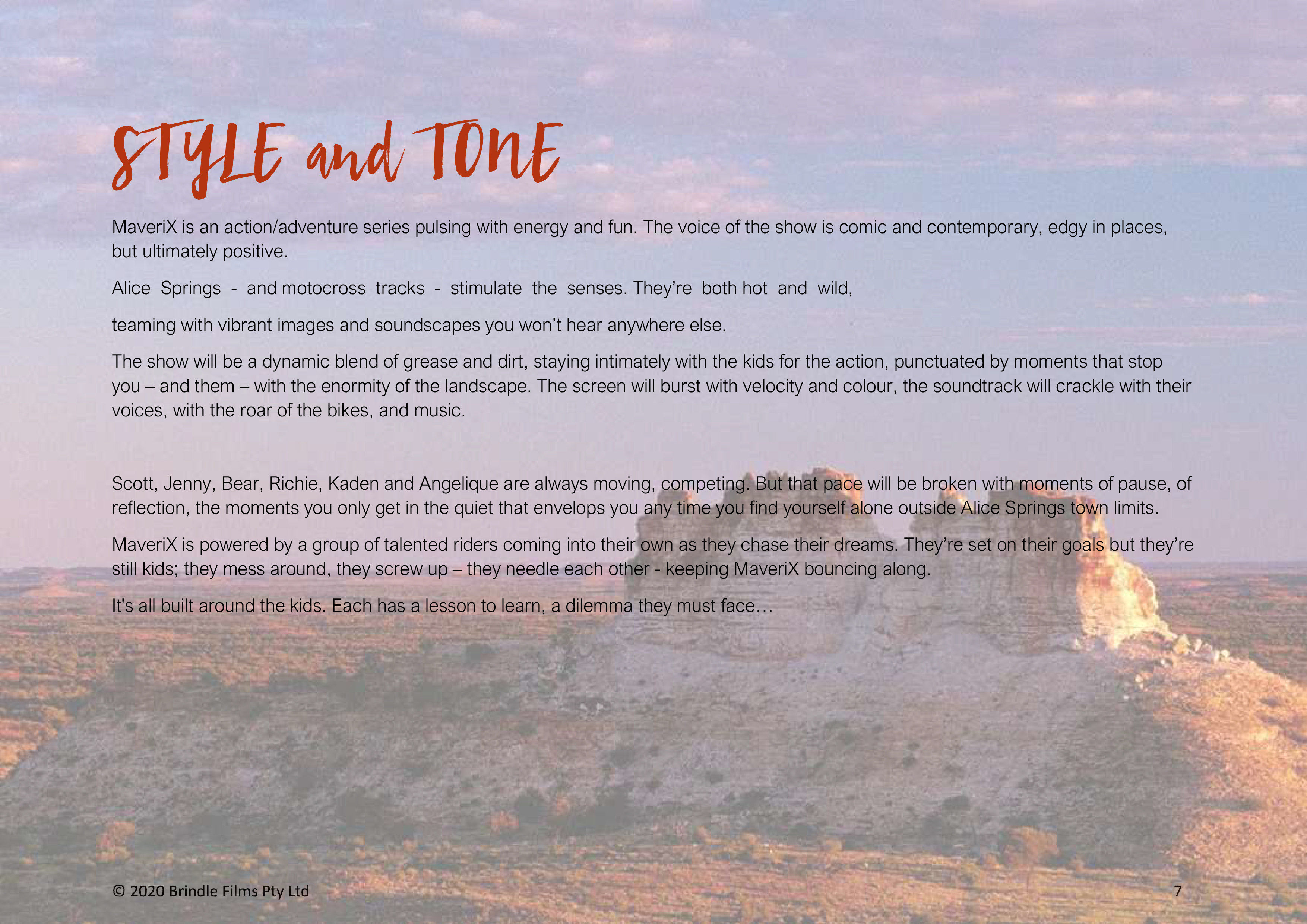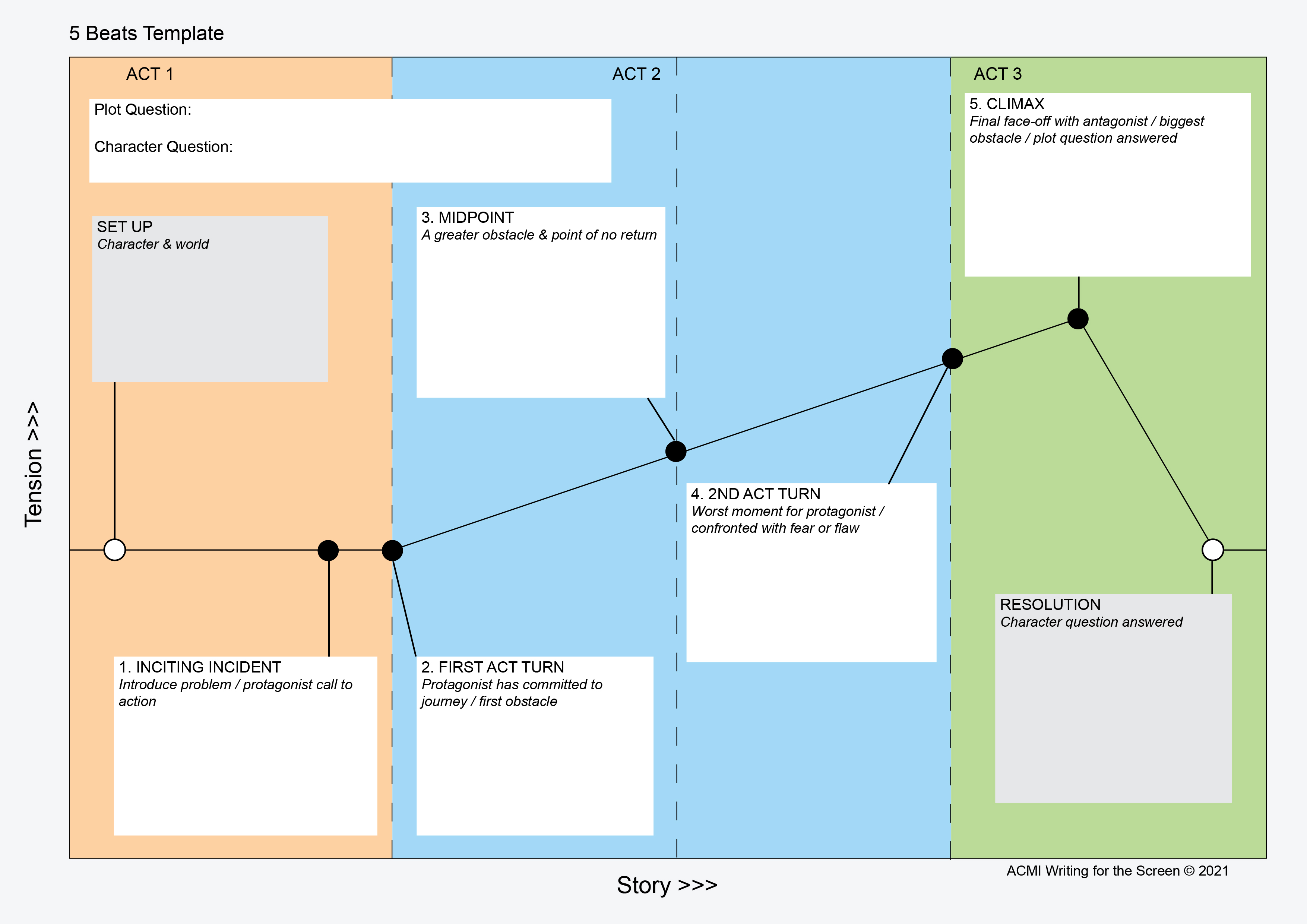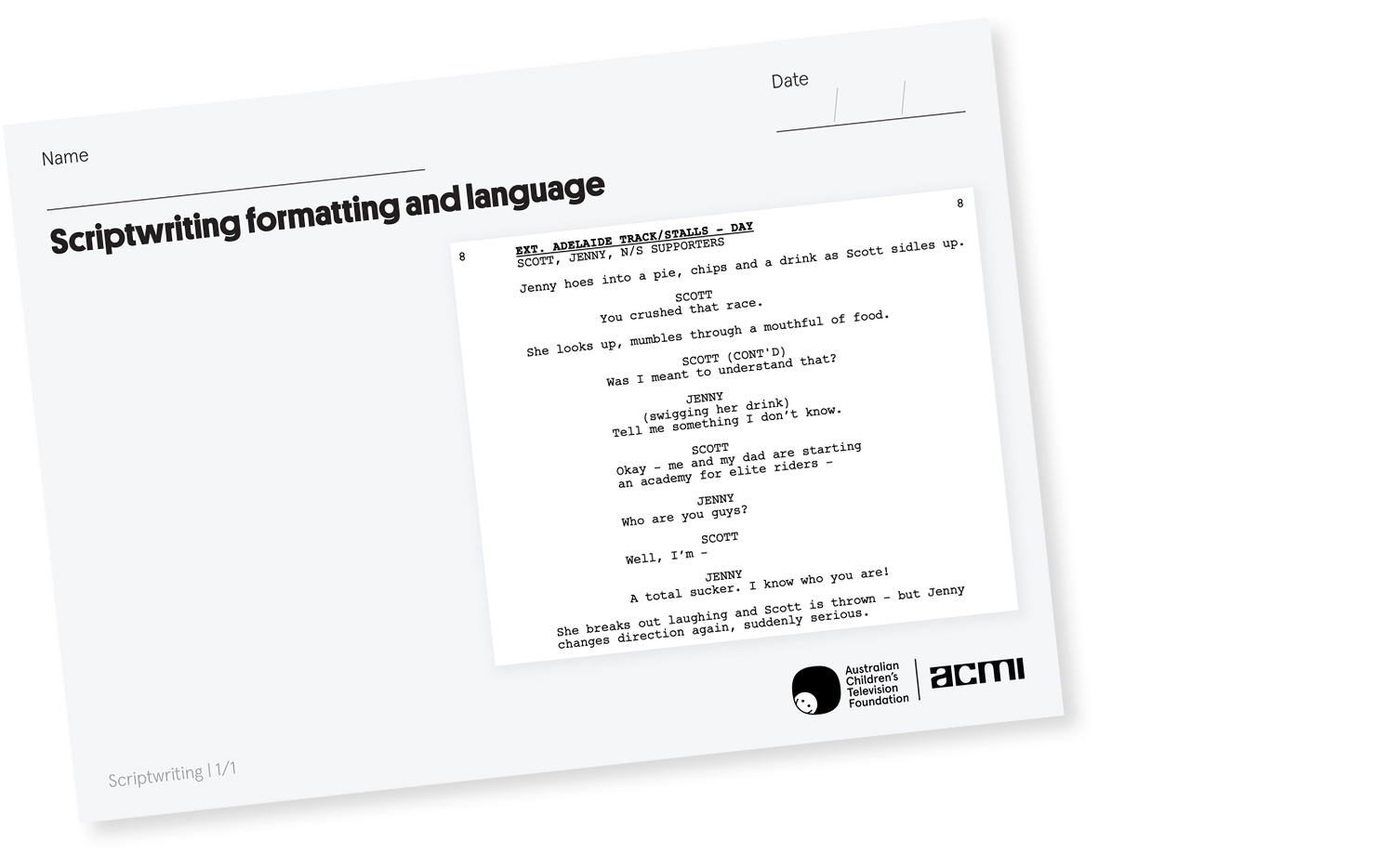Screen stories provide access to innovative ideas, validate our identities and shape our characters. Before these stories make it to our screens, they are created through the art of story building and screenwriting. This video sequence resource takes you behind the scenes with MaveriX creators, Rachel Clements, Sam Meikle and Isaac Elliot to learn about the process of bringing a story to life on
screen.

Teacher notes
Suitable for Years 5-8, this learning resource shares interviews with creatives to explore the process of story building and screenwriting from the Australian children's television program, MaveriX. It is structured so that students can work through the resource independently in their production teams or as a class with teacher guidance.
By working through the short learning tasks and video interviews, students discover the collaborative nature of storytelling for the screen first-hand from MaveriX creators Rachel Clements, Sam Meikle and Isaac Elliot. Students work in production teams of 4-6 students throughout this sequence of tasks to develop an original story and script.
Alternatively, you may decide to select and focus on particular videos and elements of the
screenwriting process. Each video offers inspiration for students to think and write creatively.
Australian Curriculum links:
- Year 5 English and Media Arts: AC9E5LA07, AC9E5LA08, AC9E5LE04, AC9E5LE05, AC9E5LY03, AC9E5LY06, AC9E5LY07, AC9AMA6C01, AC9AMA6P01
- Year 6 English and Media Arts: AC9E6LA03, AC9E6LE05, AC9E6LY01, AC9E6LY03, AC9E6LY04, AC9E6LY06, AC9E6LY07, AC9AMA6C01, AC9AMA6P01
- Year 7 English and Media Arts: AC9E7LA03, AC9E7LA08, AC9E7LE03, AC9E7LE05, AC9E7LE07, AC9E7LY01, AC9E7LY02, AC9E7LY03, AC9E7LY06, AC9E7LY07, AC9AMA8C01, AC9AMA8C02, AC9AMA8P01
- Year 8 English and Media Arts: AC9E8LA03, AC9E8LE02, AC9E8LE06, AC9E8LY02, AC9E8LY03, AC9E8LY06, AC9E8LY07, AC9AMA8C01, AC9AMA8C02, AC9AMA8P01
This resource was co-developed by the ACTF and ACMI Education.
Watch: We asked Rachel, Sam and Isaac to introduce themselves and tell us where the original idea of MaveriX came from.
Watch: We asked Rachel, Sam and Isaac where students can look for inspiration when developing their own stories.
Reflect: What are some places you can look for story ideas? What prompts can you share to help brainstorm an original story idea? Working in your production team, write a list of your suggestions.
Create: Using the list from your brainstorm, work in your production team to develop an original idea for a television series. Here are a few more prompts you may like to use:
- Choose a community sport or club you know well and develop a story around the main event (e.g. Grand Final Day).
- Imagine a group of young people practising for a drama or dance performance. Describe the different characters in the group, why they enjoy performing and the challenges they might face.
- A new business has opened in town and it has the locals in disagreement. What is the business and why has it divided the community? What are some of the things that happen because of this conflict?
After your brainstorm, choose one of your ideas to develop into a story for a television series. The following activities will guide you in building the ideas for your series and then in creating a script for your first episode.
Create: Try writing a log line (a short one to two sentence summary of your tv show, that hooks the audience in and describes the story), a one-line synopsis and a detailed synopsis of your series. Read them aloud to hear whether they work well.
A synopsis is a brief summary of your story that captures all the important information – characters, storyline, the main events and a sense of the problem. It is helpful to prepare a range of synopses for your screen story, ready to engage interested producers. Each version must be compelling. This resource has good examples. Read through the series synopses for MaveriX:
Log Line:
Six riders, one team – all go, all the time!
One-Line Synopsis:
Six young motocross riders come together to form a team, to make the national titles, or crash out trying. But the biggest win of all might be the friends they make for life.
Detailed Synopsis:
To be a motocross champion takes skill, courage, strategy, aggression, a will to win, and most of all - heart.
Scoff Griffin, 15, has heart – but does he have the heart to lead? Jenny Chivas, 14, has a will to win - but she needs a will to connect. Bear Wallis, 15, has mad skills you can’t teach – and a wild streak hard to tame. Richie Peterson, 14, has the courage to go after what he wants – but not to take on his parents. Kaden Li, 14, has all the aggression in the world – and all the entitlement to go with it. Angelique Summers, 14, has strategised all her life – just to survive.
Say hello to the first intake for MaveriX. A next-level riding academy designed to supercharge their talents and set them on a course to the big time…
It’s created and coached by Cameron “Griffo” Griffin, a former Australian Supercross champion – who’s also Scott’s dad.
It all begins at the first race of the season, the Adelaide Invitational. There, Scott and Griffo begin gathering the riders they need to make a competitive team. Coming to Alice Springs, they live and train together over the summer holidays, competing at the Alice Springs Race Day, the Northern Territory Championships and finally – if all goes well – the National Championships.
But six weeks is a long time – and Central Australia is a tough place. These riders are pushed to their limits. By the training. By the environment. By each other. Kids on their own for the first time. So many new experiences they’d never get anywhere else. Real danger all round. Through it all, Scott, Jenny, Kaden, Richie, Bear and Angie find something they never expected… the best friends you could ever ask for.
Arriving back in Adelaide for the MX National Championships, the question is, have they done enough?
Has Griffo’s training prepared them?
Are they ready for the biggest stage?
Who will be the national champion?
Reflect: Why do you think it is important to know your audience before you start developing your story?
Watch: We asked Rachel to tell us why knowing your audience is important.
Reflect: Were your ideas about audience similiar to Rachel's?
Create: In your production teams, thinking about your original idea, write down a paragraph that describes the target audience for your television series.
Watch: Isaac and Sam discuss the development process for MaveriX. As they speak, note down the various documents the team had to prepare throughout the development process.
Reflect: What documents did the writing team have to create to sell MaveriX to broadcasters like the ABC?
Create: Choose three images that represent three episodes in your television show. Write three sentences to outline each episode – include who, what, where, why and how.
Watch: Rachel and Sam discuss the importance of character development for MaveriX.
Reflect: Read through Scott and Jenny’s character pages from the MaveriX story bible below. What do you notice about the language used?


Create: In your production team, write 2-3 paragraphs on each of the main characters from your story outlining their strengths, weaknesses and story arc.
Watch: Rachel and Sam explain what to include in a story bible.



Create: In your production team, create a short story bible for your series. It should include the following:
- Add your synopses
- Add your audience description
- NEW In a few paragraphs describe The World of your television series
- NEW List the key themes explored in your television series
- NEW Outline the style and tone of your television series
- NEW Write an outline of Episode 1 (this can be vague for now)
- Add your character descriptions to your bible
- Add the images that represent your episodes and find more to include throughout the bible.
Watch: Sam explains why pitching is so important to story development.
Create: In your production teams, develop a 2-minute pitch using the information you have gathered for your story bible. Present your pitch to back to your class for feedback.
Watch: Sam and Isaac explain why writers room workshops are so important.
Reflect: As a production team, discuss if you need to include anyone outside of your team in your writers' room. Is there anyone with specialist knowledge or lived experience that you should invite?
Create: Conduct a writers' room workshop to brainstorm ideas for Episode 1 of your television series. Use ACMI’s 5 beat story template to help break down the story beats in your episode.

Watch: Sam explains the scriptwriting process.
Watch: Zoe from ACMI shares some fun examples of scriptwriting formatting and structure.
Reflect: Read the following sections from ACMI’s Screenwriting resource before getting into the next activity:
Create: Download and print the below worksheet and, using all the information you just learnt, label the different sections and shorthand used in this script from MaveriX.

Create: Using your beat sheet, break up your production team and allocate different sections of your first episode. Each member of your team can then work on writing one section of the script. Remember to keep collaborating and checking on each other throughout the writing process.
Watch: We asked Sam and Isaac why a table read is so important. Watch the answer below.
Create: Ask others to review your script and request feedback. You may like to ask your teacher or another production team to read your script. Update your script based on the feedback you receive.
Watch: We asked Rachel, Sam and Isaac how scripts are revised and changed throughout the production process.
Create: Ask others to review your script and request feedback. You may like to ask your teacher or another production team to read your script. Update your script based on the feedback you receive.
You have written a whole episode script and you are ready for the next stage of production. Congratulations!
Watch: Before you move onto the next stage check out this advice from Rachel, Sam and Isaac as you continue your screenwriting journey.
Check out ACMI’s Film It resources to explore the next stages in the production process.

This learning resource is supported by the Strategic Partnerships Program through the Victorian Department of Education.
